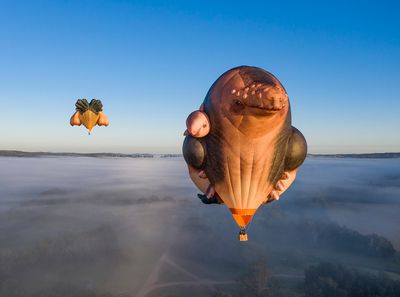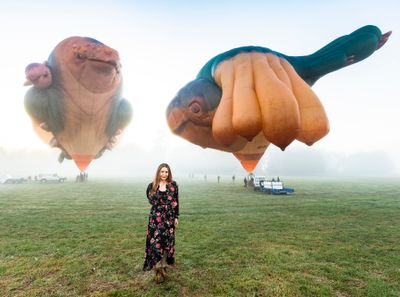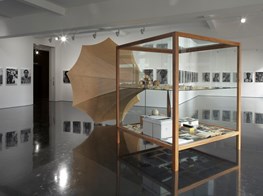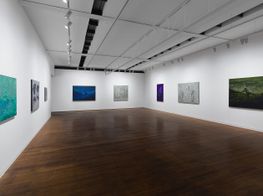Patricia Piccinini’s Skywhalepapa to Fly Over Melbourne
The hot air balloon sculpture is a companion to Skywhale (2013), the ten-breasted female of the species launched for Canberra's centenary.

Patricia Piccinini, Skywhalepapa (2020), right, and Skywhale (2013), left. Courtesy the artist and National Gallery of Australia.
UPDATE: Patricia Piccinini's Skywhale and Skywhalepapa will take flight over Melbourne on the morning of Saturday 19 March. Catch them from 6am at Corben Oval. The following interview was originally published on 30 January 2021.
Patricia Piccinini's favourite part of flying Skywhalepapa (2020) happens before it even leaves the ground.
'I think the loveliest thing is seeing them inflate and come to life,' Piccinini told Ocula Magazine.
The way the balloon is designed, Skywhalepapa fills with air first, before his offspring pop into being. The 25-metre tall, knobbly beaked whale is a tower of paternal strength, sheltering nine baby skywhales close to his body.
'If Skywhale, the female, was about wonder, the idea of nature evolving into what we have today, Skywhalepapa is about care,' she says. 'We see him caring for these nine babies. That's a very strong visual image.'
She says there are still too few examples of paternal care in popular culture, and too many where fathers are authoritarian, even violent figures. By way of example, she said, 'we get the word "lynched" from a father in Ireland who hung his own son because he went against his rules around who he could have a relationship with.'
Skywhalepapa is stable, both emotionally and aeronautically. It's a much more vertical design than Skywhale, which tends to roll and sway as it moves through the air. Because of how they're designed, the whales can only carry three human passengers, as opposed to commercial balloons, which typically carry eight or more.
'He flew really well' on his first flight, Piccinini said. 'He was able to catch the currents, float around, and come back to the exact same spot.'
Engineering a successful hot air balloon scupture is complex. Strictly speaking, the skywhales are hot and cold air balloons. While hot air is needed to create lift and get the skywhales airborne, cold air is used in the appendages that appear to hang down, such as Skywhale's breasts and face, to keep them from floating up and putting a potentially disastrous strain on the balloon.
The skywhales were commissioned by the National Gallery of Australia, the first art institution to collect hot air balloon artworks.
'They're about half a tonne of nylon, but they pack down to about the size of two dining room tables,' Piccinini said. 'They're very heavy but they're not big. So they can easily be held inside the storage facilities of the National Gallery.'
Skywhalepapa is the latest in a long list of fictional species that Piccinini has created, often using silicone and human hair. Past pieces include unusual combinations of humans with animals, manmade objects such as shoes and cars, and, more recently, plants.
Sapling (2020) is a flesh and hair being with plant-like roots instead of limbs that sits on the shoulders of a man—a way of carrying a child Piccinini says is usually easier for fathers. As with Skywhalepapa, she wanted to depict an intimate paternal relationship, but this time draw attention to our relationships with flora, which she said have their own intelligence and agency we are only now beginning to understand.
That species might evolve in such radical ways as Sapling as our world changes, even if we need to step in to facilitate those changes, is something Piccinini believes we need to discuss as a community. Genetic modification using new technologies like CRISPR could, for instance, help us treat human conditions like cystic fibrosis or give organisms on coral reefs a chance of surviving warming sea temperatures.
'The kind of work I make is not an apology for this kind of technology, and it's not saying that this is something we have to be wary of,' she said. 'It says well, this is part of our life, it's a given, and we all come from this process of evolution, we are physically capable of change, and we know change is not gradual. It jumps.'
'Whales evolved from little hoofed animals, something in between a donkey and a pig,' she said. 'And these hoofed animals went into the sea and started to eat from the sea and became gigantic. They can hold their breath for half an hour, they can breastfeed underwater, give birth underwater—they do so much in this difficult environment. The idea behind Skywhale was if these animals could go into the sea and evolve this amazing way of living, they could easily have gone into the sky like bats have. What would they look like?'
'Skywhalepapa goes further,' she continued. 'Part of evolution is care, which is becoming more and more important, whether it's with regards to climate change or the pandemic.'
Ultimately, she said, 'if we can conform to environmental conditions, we have a better chance of survival. In the end that's what's most incredible about being alive—life lives. That's what it wants to do. That's kind of scary but it's also kind of liberating. To me it's extraordinary.'
Following three flights scheduled over Canberra, Skywhale and Skywhalepapa will go on tour around Australia, beginning mid-April in Albury, New South Wales.—[O]













































































































































































